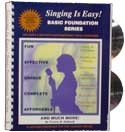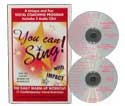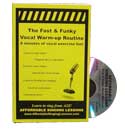FREE SINGING LESSON

| Home
Page SING
SMART FAQs and INFO LEARN
TO SING AT HOME PRIVATE
SINGING LESSONS GROUP
VOICE CLASSES
STUDENT CENTER BE
A SINGING IDOL FREE
SINGING STUFF SINGING
TEACHER CENTER |
BECOME
A MASTER OF RESONANCE Q. Dear Coach, Do
you have some hints that one can apply to articulation.
I sometimes find that with certain words, (and I cannot
think of an example right now) my voice fails me. ???
Now
say them again, only imagine that each syllable is grounded,
or has a central point, somewhere inside your mouth.
We’ll refer to this certain central space as “X”.
This “X” is going to move in your mouth.
Can you determine the direction?: If you can’t visualize the “X” moving from the front to the back of your mouth as you recite the vowels, try saying them again but this time over-exaggerate your lip and facial movements from a “wide EE” to a very round “OO.” This experiment should do the trick to show you how different vowels change the shape and the “central point” inside your mouth. Since changing the size and the shape of a resonating cavity changes the tone of your voice (and your mouth is the all important Oral Cavity), it becomes more obvious of how the pronunciation of words and controlling articulation effects singing. Once this concept is understood, the question usually changes to…so how can I become a master of resonance and maintain complete control over my voice? Here are a few tips to get you started on the right track: 1) Determine your favorite and least-favorite vowel. This usually translates as the vowel that is the easiest to sing over all pitch ranges (favorite) and the vowel that gives you the most difficulty over all pitch ranges (least-favorite). (If your challenge is a certain vowel in a certain pitch range, this will work for you too!) Once you determine your favorite vowel, use it to your advantage. Sing exercises on this vowel first. Then work through each vowel until all of them are as “easy” as your favorite vowel. This may take several or even many practice sessions, but if you can sing it on one vowel you can sing it on any vowel. Sometimes it just takes learning how to readjust certain singing mechanics to accommodate the physical changes in the voice instrument. If you are really trying to sing a specific song, use this exercise with it. Sing the song on your favorite syllable (preceded by a consonant) and then continue to practice it until you are comfortable on all the notes in all the ranges. Then move to the next vowel in line. Once you are done with all the vowels, or begin to get tired, sing it one last time or two on the words. You should begin to notice a difference within a few practice sessions. If your challenge is more about you not being able to sing the note period…that is a different discussion entirely. See “Should I Sing this in my Head Voice or Chest Voice” at http://SingingIsEasy.com/freesingingarticles.html 2) Learn the concept of shaping the back of your mouth – use it as a resonating control instead of a slave to the vowel you are singing. Make yourself yawn. Be conscious of that big space that becomes available inside your mouth as your brain commands the opening to widen so more oxygen can be provided. To be a master of resonance, you need to learn to consciously widen that space without forcing an uncontrollable yawn. The wider that space remains in the back of your throat the easier it will be to access all of the remaining resonating cavities. So learn to use the front of your mouth and lips to form the necessary consonants and shapes to round out the proper vowel, but keep the size and shape of the back of your mouth more consistent. End result, your sound will become more consistent. Right now, be sure you understand the concept of why this should work, even if you have no idea of how to make it happen. 3) A simple trick to get you started right away is to think about adding more “Ah” to the back of your throat. Here are a few examples: Sing the word “life” on any pitch. Now sing it again, but consciously put more of an “ah” into the word, concentrating on the back of your mouth. Try it now with the word, “love.” Love is a word used in many songs and many times it is sung like this: “luuuuhvvvvvvve.” This pronunciation does not take advantage of your resonating power and closes to the “v” before giving the vowel proper attention. Try it again with this kind of idea, “laaaahhhhhove. Remember that more than anything else, the “ah” should be more of a sensation and mental thought process. Your audience will simply hear a nicer sounding “love.” 4) Avoid tension in the lips, jaw and face and develop dexterity. Do relaxation exercises to warm-up your facial muscles during your vocal warm-up. Include lip diction exercises. These could be tongue twisters or singing exercises concentrating on different consonants followed by different vowels. Do these exercises with the understanding that the more control you have over your facial muscles, the more control you have over your diction. Always remember the rule: tension takes away from control and always reveals itself in your singing tone. Don’t overlook tension in any area of the voice instrument. 5) Take responsibility for your own vocal development. Becoming a master of resonance is just a portion of what it takes to become a master of singing. All of the mechanics of the voice work together as a team … and you are only as strong as your weakest link.
|
|
|||||||||
Site designed by WebSmartStudios.biz.


